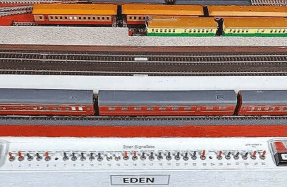
Queensland Railways (QR) 1460/1502 class Diesel Electric Locomotives.
In HOn3½ and HO scale by SDS Models in partnership with CGL Models.
Website: www.sdsmodels.com.au
Phone 0431 423 878
Email: sales@sdsmodels.com.au
Website: www.cglmodels.com.au
Phone 0407 559 086
Email: info@cglmodels.com.au
Price: AUD $335.00 DC, $485.00 DCC+Sound.
1460 Class the prototype
In September 1963, Queensland Railways (QR) awarded Clyde Engineering Co. a contract to supply 12, 90-ton mainline locomotives. The new locomotives were very similar to the 1450 class under the bonnet, with Co-Co bogies, and a 12 cylinder, 1425hp. EMD 567C prime mover. The car body had a few more curves and was more pleasing to the eye. These locomotives were built by Commonwealth Engineering at Salisbury in Brisbane, and became known as the 1460 class.
Class leader, locomotive No. 1460 entered service on 20 April 1964. Two more contracts saw a total of 42 locomotives built (1460 – 1501), all in service by August 1966. Six locomotives were fitted with dynamic brakes grilles and fan installed the No 1 end short hood. These were known as elephant ears locomotives to railfans and to crews as ‘head scalpers’. To celebrate Queensland Railways centenary in 1965, 1461 was painted in a gold scheme and was named ‘Centennial’, affectionately called the ‘The Golden Holden’. As delivered, all locomotives were painted in the blue scheme, and received the QR logo after 1970. From 1973 onwards, the hook drawgear were replaced with auto couplers. In later years, the footplate colour changed to a more serviceable grey colour. The class was the first to be fitted with station protection device (magnets located at the distant signal would activate the locomotives vigilance control system (VCS). The class were limited to 620 tons from Brisbane to Toowoomba, and on passenger trains 15 cars was the maximum load from Brisbane to Bundaberg.
At first, from their base in Brisbane the locomotives worked the North Coast Line (NCL) on the ‘Sunlander’ services, to Roma on the ‘Westlander’ and other long distance mail/ passenger trains. At around this time QR introduced new steel wagons and commenced running express freight trains at 50 mph, thus giving the class extra services to work. Between long-haul jobs, the class could also be found working Brisbane suburban trains. By 1969, the class had spread their wings even further working the ‘Inlander’ passenger services on the Mt Isa line, though generally they were ‘pool’ locomotives based at Mayne (Brisbane). In the mid 1970’s, several of the class were allocated to the Mt. Isa line. The locomotives were worked hard with many travelling over three million kilometres. I recall working the ‘Sunlander’ south out of Mackay in 1967 – the locomotive log showed the engine had left Mayne, worked the Wallangarra Mail to Toowoomba, returned to Brisbane on a train from Wallangarra, that night worked the ‘Sunlander’ north to Cairns, had been to Cairns and now was just under 24 hours from being back in Mayne, and the week was not over.
Following the electrification of the NCL and the Central Queensland (CQ) coal fields in the late 1980’s, newer, more powerful locomotives took over their work and many were placed into storage. The class also had its share of accidents to the point


